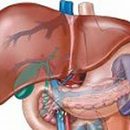Obesity in most cases leads to the development of concomitant diseases. The leading place is occupied by arterial hypertension, type 2 diabetes and violation of the reproductive function in women.
Content
Obesity, regardless of its reasons, is accompanied by pathological changes in many internal organs and systems. Most often, obesity leads to the development of arterial hypertension, is a risk of type 2 diabetes mellitus and reproductive disorders.
Arterial hypertension in obesity
 Arterial hypertension is one of the most common chronic diseases. It is the main risk factor for the development of ischemic heart disease, including myocardial infarction, and the main cause of vascular diseases of the brain, including stroke.
Arterial hypertension is one of the most common chronic diseases. It is the main risk factor for the development of ischemic heart disease, including myocardial infarction, and the main cause of vascular diseases of the brain, including stroke.
One of the reasons for the occurrence of arterial hypertension, along with genetic predisposition, age and gender, is the excess body and obesity. More than 50% of patients with obesity, arterial hypertension was revealed.
If the weight is higher than the norm, and the pressure is steadily increased (more than 140/90 mm RT. Art.), then this is not just a reason to visit the cardiologist. This is the signal of the body to urgent lifestyle change. In this case, not any increase in body weight carries the patient the same danger. The least favorable for the patient a combination of arterial hypertension with the so-called abdominal type of obesity, when fat is predominantly postponed in the abdomen.
Simple marker of abdominal type of obesity is to increase the waist circle in men more than 102 cm, in women - more than 88 cm. Such fat is not just postponed in the abdomen. Located in the abdominal cavity of a person around the internal organs, it is a chemically and hormonally active fabric, synthesizing hormone leptin - a hormone responsible for the development and progression of obesity, as well as highlighting the bloodstream free fatty acids toxic toxic products. The marker of a lipid metabolism in this case is an increase in the level of triglycerides and a reduction in blood levels «Good lipids» - so-called high density lipoproteins.
Changes do not bypass the side and vessels, is disturbed, first of all, the coagulating system of blood, which significantly increases the risk of blood clots in the vessels of vital organs - heart and brain. Thus, at first glance, a pinkish patient with a little «Zhirchom» In the abdomen and high pressure, as it were, the health of health, and in fact - this is a deeply sick person who is hard to move, and a small physical activity causes shortness of breath. The risk to earn in this case the myocardial infarction or stroke 4-6 times higher than that of a person of the same age with normal body weight and normal blood pressure. Such a patient and treat very difficult. And this is understandable, since in parallel you need to solve several tasks: reduce the pressure and body weight, normalize the exchange of carbohydrates, lipids, fats, stabilize the blood coagulation system. Have to resort to the help of many specialists. But fortunately, all the factors referred to in this article are reversible, that is, they can be eliminated, or at least - to control well. Knowledge of accurate mechanisms for the development of the disease helps correctly and individually approach to solving this complex problem.
Sugar diabetes obesity
Obesity, especially abdominal, the main risk factor for the development of type 2 diabetes mellitus.
Type 2 diabetes is one of the most important problems of modern medicine, which is associated with both steadily growing prevalence and high frequency and severity of complications of this disease.
Obesity visceral, plays an important role in the development of insulin resistance (insufficient response of body cells on insulin when it is sufficient in blood). Due to the insufficient action of insulin, the percentage of blood glucose increases. This in turn affects the selection (secretion) of insulin and tissue sensitivity to it, and this closes a vicious circle in the development of type 2 diabetes mellitus.
The main symptoms of the disease:
- thirst
- Increased urine release (more at night)
- Increased fatigue
- Reduced performance
- Increased or inexplicable reduction (in persons with excess body) body weight with saved appetite
- inclination to colds
Type 2 diabetes, as a rule, develops slowly, often for the first time it is detected when accessing a doctor about skin ferrous, furunculosis, other diseases. In some cases, type 2 diabetes mellitus detects when applying for the following complications:
- Violation of vision, cataracts
- Peripheral vascular diseases (angiopathy)
- Disorders of the kidney function
- Impotence or erectile dysfunction
Diabetes diagnosis is confirmed by laboratory diagnostics:
- 3-fold definition of glucose in an empty stomach
- Determination of the level of glycated hemoglobin (allows you to estimate the condition of carbohydrate metabolism for 90 days) or fructosamine level
- Determining the level of glucose in the urine
- Hormonal studies (C-peptide level)
The main stages of type 2 diabetes mellitus includes:
- diet
- Medicinal therapy
- Dosage physical load
- Training of the patient and self-control
- Prevention and treatment of complications of SD
Reproductive function changes in obesity
In women with normal hormonal homeostasis, fat accumulation takes place by hyneoid type. With endocrine changes, including age, when the balance of genital steroids in a woman is shifted towards androgen, it is possible to form an abdominal (android) type of obesity.
The presence of obesity leads to a violation of the reproductive function of the woman, is accompanied by a high frequency of angulation (lack of ovulation), hyperandogenic states, impaired menstrual cycle, infertility, various hyperplastic processes (hyperplasia, endometrial polyposis) by high risk of endometrial cancer, ovarian, mammary glands, spontaneous interruption of pregnancy complicated by pregnancy and childbirth.
With an alimentary obesity, 6 times more often differ impaired menstrual function and almost 2 times more often - primary infertility. There is a direct relationship between the increase in body weight and the severity of ovarian disorders (disorders of the ovarian function).
The necessary method of treating the violation of the reproductive function for women with obesity is to reduce body weight, while the hormonal profile of obese women is changed, the menstrual cycle is restored.
Special programs have been developed for the treatment of impairment of the menstrual cycle, polycystic ovarian syndrome, infertility in women with obesity, which are included in the first stage of the event aimed at reducing body weight:
- Reducing diet
- physical exercise
- Medical therapy of obesity
- Nutrition Recommendations
Thus achieved decrease in body weight is sufficient to restore various disorders of the menstrual function, without any additional hormonal therapy.If it does not occur in the full recovery of the menstrual disorder - the second stage of treatment is carried out special hormonal therapy.









